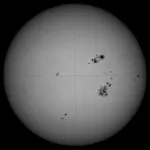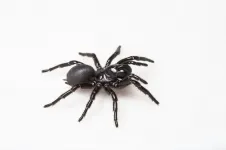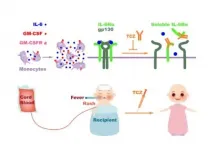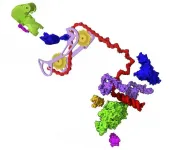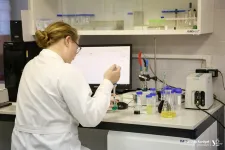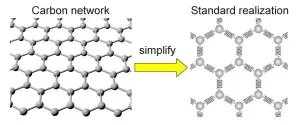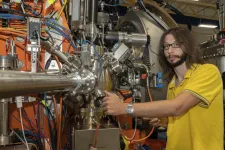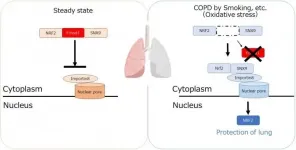(Press-News.org) BIRMINGHAM, Ala. - An experimental drug reported in Nature Communications suggests that a "path is clearly achievable" to treat currently untreatable cases of cystic fibrosis disease caused by nonsense mutations. This includes about 11 percent of cystic fibrosis patients, as well as patients with other genetic diseases, including Duchenne muscular dystrophy, β-thalassemia and numerous types of cancers, that are also caused by nonsense mutations.
The drug is a small molecule with a novel mechanism of action, say David Bedwell, Ph.D., and Steven Rowe, M.D., MSPH, co-senior authors. Bedwell is professor and chair of the University of Alabama at Birmingham Department of Biochemistry and Molecular Genetics, and Rowe is a professor in the UAB Department of Medicine.
To understand how a nonsense mutation causes disease -- and how the experimental drug works to suppress the mutation -- requires a close look at the biological machinery that makes proteins inside a cell.
A protein is a chain of hundreds of amino acids that then folds to its proper shape and moves to its proper place to perform its function. The chain is made, link by link, by ribosomes that read a sequence for the protein carried on messenger RNA. That sequence instructs which of the 20 different amino acids to add at each link, one by one.
In the disease cystic fibrosis, mutations affect the protein CFTR that functions at the surface of lung cells to regulate the flow of water to the mucus. A malfunctioning or absent CFTR creates very sticky mucus that allows infections in the lungs. A gene mutation that changes one of the nucleotide bases on the messenger RNA may cause an incorrect amino acid to be placed in the protein chain, altering its function. The nonsense premature termination codons that Bedwell and Rowe study cause a different problem -- the mutation forces the ribosome to stop protein synthesis in mid-course, yielding an incomplete protein. It also causes nonsense-mediated mRNA decay.
Thus, Bedwell, Rowe and colleagues wanted to find small-molecule compounds that would make the ribosome skip through the nonsense premature stop mutation, permitting the ribosome to continue full synthesis of the protein. They hoped to find readthrough agents that have a novel mechanism and function better than current ones, such as aminoglycoside antibiotics, which have poor efficacy.
The researchers used rat cells that carried a modified gene from a deep-sea shrimp to test hundreds of thousands of compounds. The gene encodes NanoLuc luciferase, but with a modification to place a premature termination codon in mid-gene. A small molecule that causes the ribosome to readthrough the premature stop would produce intact luciferase, making the cells glow with bright luminescence.
This reporter gene allowed a team at Southern Research to test 771,345 compounds, using high-throughput screening. Of the 180 compounds showing readthrough activity, the small molecule SRI-37240 was the most active.
Researchers found that SRI-37240 restored the function of human CFTR genes with premature termination codon mutations, as tested in rat cell cultures. It significantly increased the amount of CFTR protein and slightly increased the amount of CFTR messenger RNA. An aminoglycoside called G418 is known to aid readthrough of the premature codon mutations, and researchers found that SRI-37240 and G418 acted synergistically to restore CFTR function.
They found that SRI-37240 induces a prolonged pause at stop codons of messenger RNA and inhibits termination of protein synthesis at premature termination codons without stimulating readthrough at the normal termination codons found at the end protein-encoding sequence on the messenger RNA.
Medicinal chemists synthesized 40 derivatives of SRI-37240, and one, SRI-41315, was more potent and showed better physiochemical features. In human cell lines with the NanoLuc reporter gene, SRI-41315 showed much greater readthrough efficiency than SRI-37240, and SRI-41315 acted synergistically with G418.
Ribosome complexes include ribosomal proteins and other proteins that function as termination factors, translation factors and nonsense-mediated mRNA decay factors. The researchers looked at the abundance of seven of those proteins and found that SRI-41315 dramatically reduced a single termination factor called eRF1, through a proteasome degradation-dependent pathway. This novel mechanism has not been previously seen for a pharmacological agent.
To predict clinical efficacy for cystic fibrosis, researchers tested primary human bronchial epithelial cells that had endogenous CFTR premature termination codons. Neither SRI-37240 nor SRI-41315 alone increased CFTR function, but SRI-41315 together with G418 showed a significant increase in function.
This is progress, Bedwell and Rowe say, yet hurdles remain. Unfortunately, the two compounds had a deleterious effect on ion conductance mediated by the epithelial sodium channel, which limits development in their current form as a treatment for cystic fibrosis. The already known readthrough effect of aminoglycosides is also limited because these antibiotics do not restore therapeutic levels of CFTR, and they also must be given intravenously and can be toxic.
Bedwell and Rowe say it is increasingly likely that multiple distinct agents with different mechanisms of action will be required to impart a clinically impactful response. They concluded, "While further medicinal chemistry is needed to identify readthrough compounds that maximally impact CFTR function without undesirable off-target effects, the results presented here suggest this path is clearly achievable."
INFORMATION:
Co-first authors of the study, "A small molecule that induces translational readthrough of CFTR nonsense mutations by eRF1 depletion," are Jyoti Sharma, UAB Department of Medicine, and Ming Du, UAB Department of Biochemistry and Molecular Genetics.
Other co-authors are Eric Wong, Hermann Bihler, Feng Liang, Jerome Mahiou, Josef Saltz and Martin Mense, Cystic Fibrosis Foundation Therapeutics, Boston, Massachusetts; Venkateshwar Mutyam, Yao Li, Jianguo Chen, Ning Peng and Liping Tang, UAB Department of Medicine; Kari Thrasher, Kaimao Liu and Kim M. Keeling, UAB Department of Biochemistry and Molecular Genetics; Lianwu Fu, UAB Department of Cell, Developmental and Integrative Biology; Jamie Wangen and Rachel Green, Johns Hopkins University School of Medicine, Baltimore, Maryland; Bini Mathew, Robert J. Bostwick, Corinne E. Augelli-Szafran and Mark J. Suto, Southern Research, Birmingham, Alabama; Andras Rab, Jeong Hong and Eric J. Sorscher, Emory University, Atlanta, Georgia; and Eric M. Mendenhall and Candice J. Coppola, University of Alabama in Huntsville, Huntsville, Alabama.
Support came from the Cystic Fibrosis Foundation and from National Institutes of Health grants P30DK072482.
At UAB, Bedwell holds the James C. and Elizabeth T. Lee Chair of Biochemistry. Rowe holds the Nancy R. and Eugene C. Gwaltney Family Endowed Chair in Medical Research, and he is director of the Gregory Fleming James Cystic Fibrosis Research Center.
Scientists from the University of Graz, Kanzelhöhe Observatory, Skoltech, and the World Data Center SILSO at the Royal Observatory of Belgium, have presented the Catalogue of Hemispheric Sunspot Numbers. It will enable more accurate predictions of the solar cycle and space weather, which can affect human-made infrastructure both on Earth and in orbit. The study came out in the Astronomy & Astrophysics journal, and the catalogue is available from SILSO -- the World Data Center for the production, preservation, and dissemination of the international sunspot number.
Our Sun is a big boiling ball of gas, most of which is so hot that electrons are ripped off from atoms, creating a circulating mix of charged particles, called plasma. These moving charges ...
A potentially life-saving treatment for heart attack victims has been discovered from a very unlikely source - the venom of one of the world's deadliest spiders.
A drug candidate developed from a molecule found in the venom of the Fraser Island (K'gari) funnel web spider can prevent damage caused by a heart attack and extend the life of donor hearts used for organ transplants.
The discovery was made by a team led by END ...
The research team led by Prof. WEI Haiming and Prof. TIAN Zhigang from Division of Life Sciences and Medicine, University of Science and Technology of China (USTC) of the Chinese Academy of Sciences (CAS), collaborating with the research group led by Prof. SUN Zimin from the First Affiliated Hospital of USTC revealed the pathological mechanism of severe pre-engraftment syndrome (PES) after umbilical cord blood transplantation, not only providing a treatment strategy for patients with PES, but significantly guiding for further improvement in the curative effect of unrelated cord blood transplantation (UCBT). This study was published in Nature Communications.
UCBT is an important means to cure hematological ...
In February 2020, a trio of bio-imaging experts were sitting amiably around a dinner table at a scientific conference in Washington, D.C., when the conversation shifted to what was then a worrying viral epidemic in China. Without foreseeing the global disaster to come, they wondered aloud how they might contribute.
Nearly a year and a half later, those three scientists and their many collaborators across three national laboratories have published a comprehensive study in Biophysical Journal that - alongside other recent, complementary studies of coronavirus proteins ...
Russian scientists have synthesized chemical compounds that can stop the degeneration of neurons in Alzheimer's, Parkinson's, and other severe brain pathologies. These substances can provide a breakthrough in the treatment of neurodegenerative pathologies. New molecules of pyrrolyl- and indolylazine classes activate intracellular mechanisms to combat one of the main causes of "aged" brain diseases - an excess of so-called amyloid structures that accumulate in the human brain with age. The essence of the study was published in the European Journal of Medicinal Chemistry. Experts from the Institute of Cytology of the Russian Academy of Sciences, the Institute of Organic Synthesis of the Ural Branch of the Russian ...
A new mathematical model helps predict the tiny changes in carbon-based materials that could yield interesting properties.
Scientists at Tohoku University and colleagues in Japan have developed a mathematical model that abstracts the key effects of changes to the geometries of carbon material and predicts its unique properties.
The details were published in the journal Carbon.
Scientists generally use mathematical models to predict the properties that might emerge when a material is changed in certain ways. Changing the geometry of three-dimensional (3D) graphene, which is made of networks of carbon atoms, by adding chemicals or introducing topological defects, can improve its catalytic properties, for example. But it has been difficult for scientists to understand why this happens exactly.
The ...
Researchers from the Paul Scherrer Institute PSI and the Brookhaven National Laboratory (BNL), working in an international team, have developed a new method for complex X-ray studies that will aid in better understanding so-called correlated metals. These materials could prove useful for practical applications in areas such as superconductivity, data processing, and quantum computers. Today the researchers present their work in the journal Physical Review X.
In substances such as silicon or aluminium, the mutual repulsion of electrons hardly affects the material properties. Not so with so-called correlated materials, in which the electrons interact strongly with one another. The movement of one electron in a correlated material leads ...
Prof. LI Chuanfeng, Prof. XU Jinshi and their colleagues from Prof. GUO Guangcan's group, University of Science and Technology of China (USTC) of the Chinese Academy of Sciences (CAS), realized the high-contrast readout and coherent manipulation of a single silicon carbide divacancy color center electron spin at room temperature for the first time in the world, in cooperation with Prof. Adam Gali, from the Wigner Research Centre for Physics in Hungary. This work was published in National Science Review on July 5, 2021.
Solid-state spin color centers are of utmost importance in many applications of quantum technologies, the outstanding one among which is the nitrogen-vacancy (NV) center in diamond. Since the detection ...
African swine fever (ASF), first detected in Germany in domestic pigs on 15 July 2021, does not pose a health hazard to humans. "The ASF pathogen cannot be transferred to humans", explains Professor Dr. Dr. Andreas Hensel, President of the German Federal Institute for Risk Assessment (BfR). "No risk to health is posed by direct contact with diseased animals or from eating food made from infected domestic pigs or wild boar".
The ASF pathogen is a virus which infects domestic pigs and wild boar and which leads to a severe, often lethal, disease in these animals. It is transferred via direct contact or with excretions from infected animals, or through ticks. The ASF virus is endemic to infected wild animals ...
Tokyo, Japan - Chronic obstructive pulmonary disease (COPD) causes illness and death worldwide. It is characterized by destruction of the walls of tiny air sacs in the lungs, known as emphysema, and a decline in lung function. Little has been known about the mechanisms by which it begins to develop. But now, researchers from Japan have found a protein that promotes the development of the early stages of emphysema, with the potential to be a therapeutic target.
COPD can be triggered by environmental factors such as cigarette smoking that result in lung inflammation. The development of inflammation involves the movement ...

